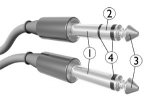luca.staffiere
New member
Hallo everyone! I am just starting to build my homerecording studio and read a book from the "for dummies" series that gave me some hints. But something about the cords I should use to link my gear is not so clear:
Basically there is this first difference between TS and TRS, one of them is unbalanced, the other instead balanced, thus providing more isolation from noise. The second is a better option when the cable is long. Then a cable can carry little current (for instrument) or a lot of current (for speakers). Question is:
1) Just how much is this current and how do I understand from the package if a cable is meant for an instrument or for speakers?
2) the wording TS and TRS also doesn't appear on the pack. Usually I was told that TRS have this double plastic ring so they are visually recognisable, but sometime I find names like "stereo cable" or "balanced cables" on cables that look like TS cable. How can I be sure?
3) What is meant by long cable and short cable? Is a 3m cable short or long? In other words, is it worth spending more money to have a balanced 3m cable?
4) How exactly do Y cable work? if I link a Y cable from the output of my keybord (a casio CDP.100) and put the two endings in two different traks, I do get two different signals that reproduce a stereo sound? how come the two ends look like TS? does that mean the whole thing is unbalanced?
Gosh, I do kinda regret the old days in wich I was just buying random cords for my gutar
I thank in advance anyone who would help me
Basically there is this first difference between TS and TRS, one of them is unbalanced, the other instead balanced, thus providing more isolation from noise. The second is a better option when the cable is long. Then a cable can carry little current (for instrument) or a lot of current (for speakers). Question is:
1) Just how much is this current and how do I understand from the package if a cable is meant for an instrument or for speakers?
2) the wording TS and TRS also doesn't appear on the pack. Usually I was told that TRS have this double plastic ring so they are visually recognisable, but sometime I find names like "stereo cable" or "balanced cables" on cables that look like TS cable. How can I be sure?
3) What is meant by long cable and short cable? Is a 3m cable short or long? In other words, is it worth spending more money to have a balanced 3m cable?
4) How exactly do Y cable work? if I link a Y cable from the output of my keybord (a casio CDP.100) and put the two endings in two different traks, I do get two different signals that reproduce a stereo sound? how come the two ends look like TS? does that mean the whole thing is unbalanced?
Gosh, I do kinda regret the old days in wich I was just buying random cords for my gutar

I thank in advance anyone who would help me


